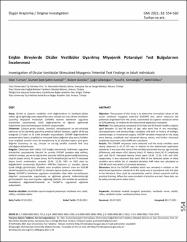Erişkin Bireylerde Oküler Vestibüler Uyarılmış Miyojenik Potansiyel Test Bulgularının İncelenmesi

View/
Date
2021Author
Turhan, SibelŞahin Kamışlı, Gurbet İpek
Gündüz, Bülent
Gökdoğan, Çağıl
Kemaloğlu, Yusuf Kemal
Göksu, Nebil
Metadata
Show full item recordAbstract
Amaç: Utrikül ve süperior vestibüler siniri değerlendiren ve Vestibulo-oküler refleks ağı ile ilgili bilgi veren objektif bir nöro-otolojik test olan Oküler Vestibüler Uyarılmış Miyojenik Potansiyel (OVEMP) testinin belirlenen uygulama standartları çerçevesinde, klinik değerlendirme ve öğrenci eğitiminde kullanılmak üzere normalizasyon verilerini oluşturmaktır
Yöntemler: Çalışma grubu otolojik, nörolojik, nöropskiyatrik ve oto-nörolojik yakınması ve bu alanlarda geçirilmiş ameliyat öyküsü olmayan, sağlıklı 18-60 yaş aralığında 33 kadın ve 33 erkek bireyden oluşmaktadır. OVEMP değerlendirme parametreleri; latans, amplitüd ve interpeak latans değerleri olup ayrıca kulaklar arası amplitüd asimetri oranı da hesaplanmış ve ±1 standart sapma içine giren değerler bulunmuş ve yaş, cinsiyet ve sol-sağ taraflar arasında fark olup olmadığına da bakılmıştır.
Bulgular: Çalışmaya dahil edilen 132 kulağın tamamında, belirlenen uygulama standartları çerçevesinde literatür ile uyumlu OVEMP cevapları elde edilmiş; verilerin cinsiyet, yaş ve sol-sağ taraflar arasında farklılık göstermediği bulunmuş olup N1 Latans (msn), P1 Latans (msn), N1-P1 Amplitüd (μV) ve N1-P1 interpeak latans (msn) ortalamaları, sırasıyla 10.44, 15.26, 9.81 ve 4.82 olup bu değişkenlerin tamamında ölçümlerin %90’dan fazlasının ±1 standart sapma içinde olduğu görülmüştür. Kulaklar arası amplitüd asimetri oranı ise %16.88 olarak hesaplanmış olup % 95,45’i ±2 standart sapma içinde yer almaktadır.
Sonuç: OVEMP’in belirlenen uygulama standartları elde edile normalizasyon değerleri çerçevesinde uygulamada ve eğitimde güvenle kullanılabileceği görülmektedir. Aynı test koşulları sağlandığı taktirde tüm klinikler de vestibuler hastalıkların değerlendirilmesinde ve OVEMP’in uygulamalı eğitimde kullanılabilir. Objective: The purpose of this study is to determine normalized values of the ocular vestibular myogenic potential (OVEMP) test, which measures the potentials originated from the utricle, transmitted via superior vestibular nerve to VOR pathway, in relation to the determined application standards. Methods: The study group composed of 33 male and 33 female healthy subjects aged between 18 and 60 years of age, who were free of any neurologic, neuropsychiatric and otoneurologic complaint and with no history of otologic, otoneurologic or intracranial surgery. OVEMP variables measured in this study were latency, amplitude and interpeak latency values, and further interaural amplitude asymmetry ratio (AAR) was calculated. Results: The OVEMP responses were detected and the study variables were clearly observed in all of 132 ears in relation to the determined application standards. It was seen that none of the variables presented any sex, age and side differences, and means of N1 latency (msn), P1 latency (msn), N1-P1 amplitude (μV) and N1-P1 interpeak latency (msn) were 10.44, 15.26, 9.81 and 4.82, respectively. It was observed that more 90% of the detected values in these variables were within the ±1 standard deviation AAR value was calculated as %16.88 and it was within ±2 standard deviation. Discussion: Since the OVEMP variables which was revealed in relation to the determined application standards in this study was in accordance with the data in the literature, they could be conveniently used in clinical researchs and for practical training. When the same standarts of practice are met, these data can be safely transferred to other clinics

















